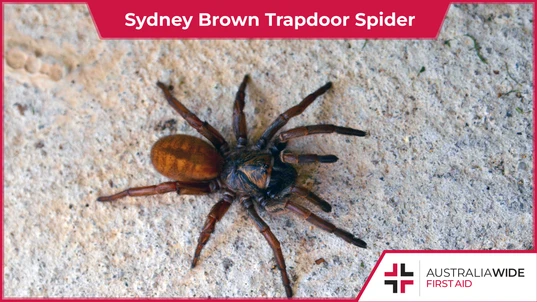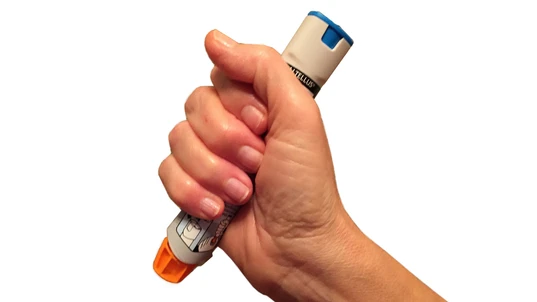Sydney Brown Trapdoor Spider

Bites and Stings

The Sydney Brown Trapdoor Spider loves being out and active during the hot summer. They are eerily similar to the deadly Funnel-web. In this article, we will give you the know-how to spot the differences between them.
The Sydney Brown Trapdoor Spider (misgolas rapax) is one cold-blooded creature that loves being out and active in the urban areas of the lawns, gardens and bushland of Sydney during the hot summer. In fact, males wander during humid weather in search of a mate. Belonging to the spider family idiopidae, The Sydney Brown Trapdoor Spider is eerily similar in appearance to the more deadly, famous cousin, the Funnel-web. This article will give you the know-how to spot the differences between them. Read on to learn a bit more about the Sydney Brown Trapdoor Spider, where it lives, and steps to take should one bite you.Appearance
The trapdoor spider is a common name for any several large, hairy, and generally harmless tropical spiders that nest in burrows lined with silk underground. The Sydney Brown Trapdoor Spider has a brown dusty looking body, with golden-tipped hairs on its body (carapace) and grey bars along the abdomen. The females are larger and less easy to identify directly. Male trapdoor spiders usually have distinct boxing glove shaped palps that are used to transfer spur. They also have a small double spur halfway up their first leg. The Sydney Brown Trapdoor Spider is often mistaken for a funnel-web spider, which is less hairy, has a more glossy appearance and has a double spur on its second pair of legs.Habitat
The Sydney Brown Trapdoor Spider spends its time in burrows commonly found throughout Sydney’s urban lawns, gardens and nature parks. It’s known to the southern area of George’s River to the northern reaches of the Hunter River Valley.Behaviour
Timid in nature and not dangerously venomous, males may rear up to attack if threatened. They tend to live in silk-lined open burrows in the ground. Sydney Brown Trapdoor Spiders, unlike their name suggests, do not make trap doors for their burrows. These spiders make a silken rim that sticks to nearby grass or fallen leaves. These bits of natural litter function as the makeshift “door” to their burrows. Unlike the funnel-web spiders, Sydney Brown Trapdoor Spiders won’t make silk trip-lines. The Sydney Brown Trapdoor plays an important role in controlling the number of beetles, cockroaches, other spiders, and moths. Waiting for the opportune time for these ground crawlers to pass their “door”, the Sydney Brown Trapdoors leap out at great speeds to seize and haul their prey into their burrow.Bite
Sydney Brown Trapdoor bites are not as venomous as the funnel-web spider bite. A bite can still be incredibly painful and cause swelling. It is recommended to exercise caution and apply a cold pack to relieve the pain if needed. If these symptoms persist, seek medical attention as soon as you can. Because of their similarities with funnel-web spiders, a photo on a phone may help in identification but should not delay the administration of first aid. Whether they’re threatening or non-threatening, it’s always a good idea to give spiders a bit of space whenever you can. Better to be on the safer side of things!First aid for a Trapdoor spider bite
Trapdoor spider bites should be treated in the same manner as a Funnel-web spider bite, as there are approximately 40+ varieties of large black spiders, so it is worthwhile to treat for the worst and hope for the best:- Keep the casualty at rest and as still as possible to stop the venom from travelling through the body.
- Constantly observe and reassure the casualty.
- Follow DRSABCD and be prepared to perform CPR
- Apply the ‘pressure immobilisation technique’ (PIT):
If the bite site is on a limb, cover it with a wide heavy elastic bandage (10 - 15 cm wide).
Ensure the bandage is firm and tight, so tight you cannot easily slide a finger between the bandage and the skin.
Apply a second heavy elastic bandage. Start from the fingers or toes and wind up the limb as far as possible. Consistent coverage (overlapping half over half) and consistent pressure (firm but not cutting off circulation) are key to an effective PIT. - Immobilise the limb and joints with a splint, or use a sling if the bite site is on an arm. Keep the limb immobilised until the ambulance arrives.

Some people can experience anaphylaxis following a bite from a Sydney Brown Trapdoor Spider. Anaphylaxis is a life-threatening allergic reaction that is generally treated with adrenaline auto-injectors, like the Epipen pictured above.
Spider bites and anaphylaxis
Some people can have a severe allergic reaction when bitten by the Sydney Brown Trapdoor Spider. This is called anaphylaxis, a condition that can be fatal in as little as 15 minutes. Symptoms include:- Tightness of the throat from swelling.
- Difficulty breathing.
- Tongue and facial swelling.
- Hoarse voice or difficulty speaking.
- A wheeze or persistent cough.
- Collapse or fall unconscious.
- Becoming pale or floppy (young children).
- Abdominal pain and vomiting.
- Hives, welts, and body redness.
Final thoughts
Sydney Brown Trapdoor Spiders are mainly harmless and mind their own business throughout the gardens and bushlands around Sydney. However, it is never a good idea to go looking for them as you may receive a nasty bite when encountered. It is recommended for you to learn first aid in the event of a bite, and be alert for an allergic reaction. Make sure to attend one of our First Aid Courses to learn more about treating various spider bites and what to do in case of an emergency.
Originally published at
https://www.australiawidefirstaid.com.au/resources/sydney-brown-trapdoor-spider
as part of the Australia Wide First Aid Articles Library









